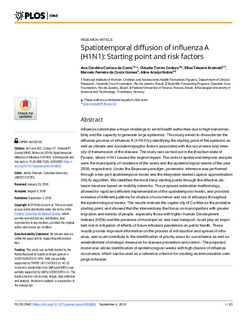| dc.contributor.author | da Costa, Ana Carolina Carioca | |
| dc.contributor.author | Codeço, Cláudia Torres | |
| dc.contributor.author | Krainski, Elias Teixeira | |
| dc.contributor.author | da Costa Gomes, Marcelo Ferreira | |
| dc.contributor.author | Nobre, Aline Araújo | |
| dc.date.accessioned | 2019-09-19T06:40:09Z | |
| dc.date.available | 2019-09-19T06:40:09Z | |
| dc.date.created | 2019-01-31T19:25:47Z | |
| dc.date.issued | 2018 | |
| dc.identifier.citation | PLOS ONE. 2018, 13:e0202832 (9), 1-20. | nb_NO |
| dc.identifier.issn | 1932-6203 | |
| dc.identifier.uri | http://hdl.handle.net/11250/2617508 | |
| dc.description.abstract | Influenza constitutes a major challenge to world health authorities due to high transmissibility and the capacity to generate large epidemics. This study aimed to characterize the diffusion process of influenza A (H1N1) by identifying the starting point of the epidemic as well as climatic and sociodemographic factors associated with the occurrence and intensity of transmission of the disease. The study was carried out in the Brazilian state of Paraná, where H1N1 caused the largest impact. The units of spatial and temporal analysis were the municipality of residence of the cases and the epidemiological weeks of the year 2009, respectively. Under the Bayesian paradigm, parametric inference was performed through a two-part spatiotemporal model and the integrated nested Laplace approximation (INLA) algorithm. We identified the most likely starting points through the effective distance measure based on mobility networks. The proposed estimation methodology allowed for rapid and efficient implementation of the spatiotemporal model, and provided evidence of different patterns for chance of occurrence and risk of influenza throughout the epidemiological weeks. The results indicate the capital city of Curitiba as the probable starting point, and showed that the interventions that focus on municipalities with greater migration and density of people, especially those with higher Human Development Indexes (HDIs) and the presence of municipal air and road transport, could play an important role in mitigation of effects of future influenza pandemics on public health. These results provide important information on the process of introduction and spread of influenza, and could contribute to the identification of priority areas for surveillance as well as establishment of strategic measures for disease prevention and control. The proposed model also allows identification of epidemiological weeks with high chance of influenza occurrence, which can be used as a reference criterion for creating an immunization campaign schedule. | nb_NO |
| dc.language.iso | eng | nb_NO |
| dc.publisher | Public Library of Science (PLOS) | nb_NO |
| dc.rights | Navngivelse 4.0 Internasjonal | * |
| dc.rights.uri | http://creativecommons.org/licenses/by/4.0/deed.no | * |
| dc.title | Spatiotemporal diffusion of influenza A (H1N1): Starting point and risk factors | nb_NO |
| dc.type | Journal article | nb_NO |
| dc.type | Peer reviewed | nb_NO |
| dc.description.version | publishedVersion | nb_NO |
| dc.source.pagenumber | 1-20 | nb_NO |
| dc.source.volume | 13:e0202832 | nb_NO |
| dc.source.journal | PLOS ONE | nb_NO |
| dc.source.issue | 9 | nb_NO |
| dc.identifier.doi | 10.1371/journal.pone.0202832 | |
| dc.identifier.cristin | 1671381 | |
| dc.description.localcode | Copyright: © 2018 da Costa et al. This is an open access article distributed under the terms of the Creative Commons Attribution License, which permits unrestricted use, distribution, and reproduction in any medium, provided the original author and source are credited. | nb_NO |
| cristin.unitcode | 194,63,15,0 | |
| cristin.unitname | Institutt for matematiske fag | |
| cristin.ispublished | true | |
| cristin.fulltext | original | |
| cristin.qualitycode | 1 | |

